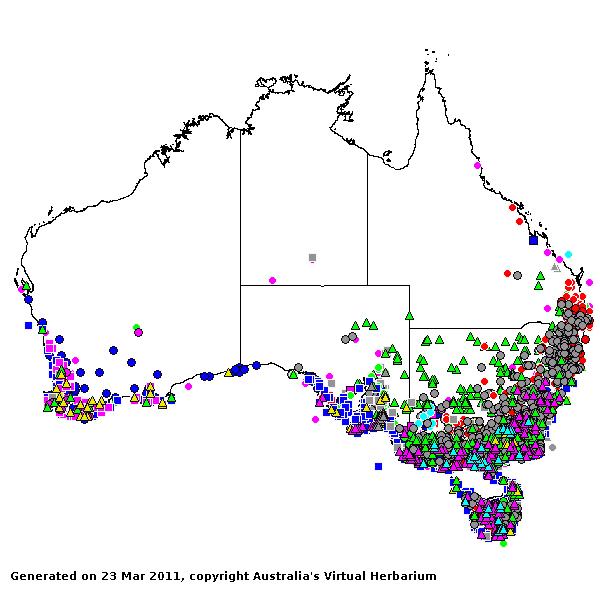Poa Sp. Pl. 67 (1753).
Derivation:. From Greek poa (grass).
Taxonomic revisions, nomenclatural references:. J.W.Vickery, Contr. New South Wales Natl Herb. 4: 145–243 (1970).
Key references (keys and floras):. G.Bentham, Flora Australiensis 7: 650–654 (1878); C.A.Gardner, Flora of Western Australia 1 Gramineae 106–110 (1952); E.E.Henty, Manual Grasses New Guinea 150–151, 154–155, 158–159 (1969); M.Lazarides, Flora of Central Australia 430–431 (1981); J.C.Tothill and J.B.Hacker, Grasses of Southern Queensland 352–354 (1983); J.P.Jessop, Flora of South Australia 4: 1896–1901 (1986); B.K.Simon, Key to Australian Grasses 147–151 (1993); S.W.L.Jacobs and S.M.Hastings, Flora of New South Wales 4: 619–628 (1993); N.G.Walsh, Flora of Victoria 2: 415–435 (1994); D.I.Morris, Student's Flora of Tasmania 4B: 209–221 (1994); E.Edgar and H.E.Connor, Flora of New Zealand 5: 129–194 (2000); D.Sharp and B.K.Simon, AusGrass (2002); J.P.Jessop, Grasses of South Australia 143–160 (2006); S.W.L.Jacobs, R.D.B.Whalley & D.J.B.Wheeler, Grasses of New South Wales, 4th ed, 344–355 (2008); A.Wilson (ed.), Flora of Australia 44A: Poaceae 2: 301–338 (2009)
W.D.Clayton & S.A.Renvoize, Genera Graminum (1986), genus (124).
Native and naturalised. About 500 species, from cosmopolitan regions. About 44 species in Australia, WA, NT, SA, Qld, NSW, Vic, and Tas. Also New Guinea, Malesia and New Zealand.
Habit. Annual or perennial, rhizomatous or stoloniferous or tufted or decumbent. Leaf blades nearly always narrow. Ligule an unfringed membrane or a fringed membrane (rarely). Plants bisexual, with bisexual spikelets or dioecious.
Inflorescence. Inflorescence paniculate, an open panicle with branches ending in single spikelets, open or contracted.
Spikelets. Spikelets laterally compressed, more than 2 flowered, with 2 or more fertile florets, solitary, pedicelled; with naked rachilla extension. Fertile spikelets disarticulating above glumes.
Glumes. Glumes more or less equal, shorter than spikelet, shorter than adjacent lemmas, pointed or blunt (rarely rounded), awnless, keeled, similar (membranous). Lower glume 1 nerved or 3 nerved. Upper glume usually 3 nerved.
Florets. Fertile florets 2–10(–15) (very rarely only one). Lemmas similar in texture to glumes, not becoming indurated, entire at apex, pointed, muticous, 5 nerved (usually) or 7–11 nerved, hairy (often with web-like hairs) or glabrous (rarely), 1 keeled. Palea relatively long to conspicuous and relatively short to very reduced, entire to apically notched (emarginate), textured like lemma, 2 nerved. Palea keels glabrous or hairy. Distal incomplete florets underdeveloped. Callus short, blunt. Lodicules 2. Stamens 3. Grain small, longitudinally grooved or not grooved, compressed laterally or compressed dorsiventrally. Hilum short. Embryo small.
Kranz Anatomy. C3.
2n = 14 or 28 or 35 or 38 or 38–117 or 42 or 43 or 44 or 56 or 50–56 or 63 or 65 or 70–72 or 76 (etc), 2, 4, 5, 6, 7, 8, 9, 10, 11, and 12 ploid (etc., and aneuploids), commonly adventive.
Habitat. Helophytic (rarely), mesophytic (mostly), xerophytic (rarely). Typically in grasslands and meadows. Shade species and species of open habitats.
Classification. Pooideae; Poeae.
Notes. Poa is an extremely uniform genus for which there is no satisfactory infrageneric classification. Its taxonomy is rendered difficult by the dearth of useful discriminatory characters, and complicated by the widespread occurrence of apomixy and introgression. The genus differs from Festuca mainly in its keeled lemma and round hilum, but there is some overlap. Species with obsolescent marginal nerves may be confused with Eragrostis, though usually a few lemmas with more than 3 nerves can be found (Clayton and Renvoize, 1986).
Types Species. P. pratensis L.
Biogeographic Element. Clifford & Simon 1981, Simon & Jacobs 1990: Cosmopolitan.


